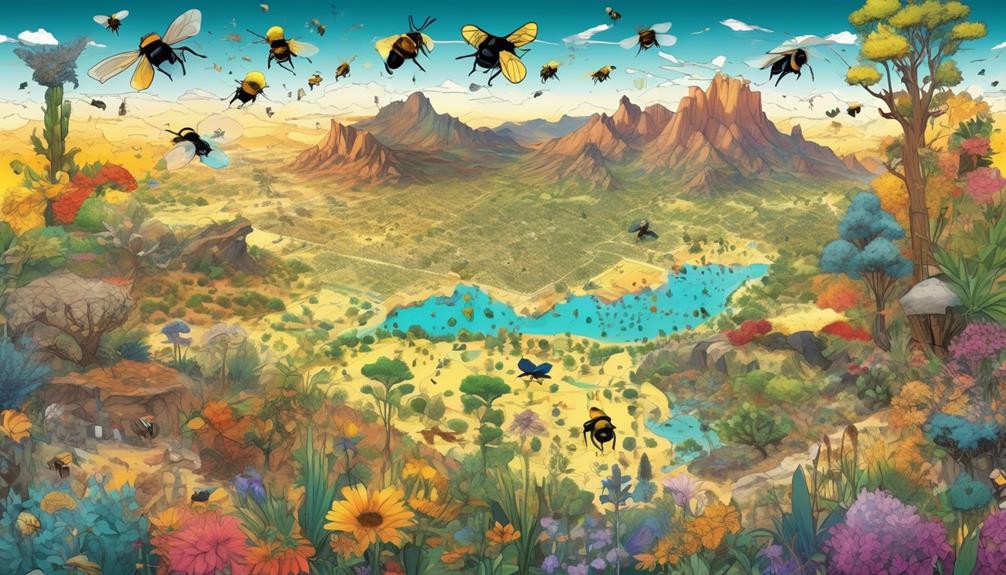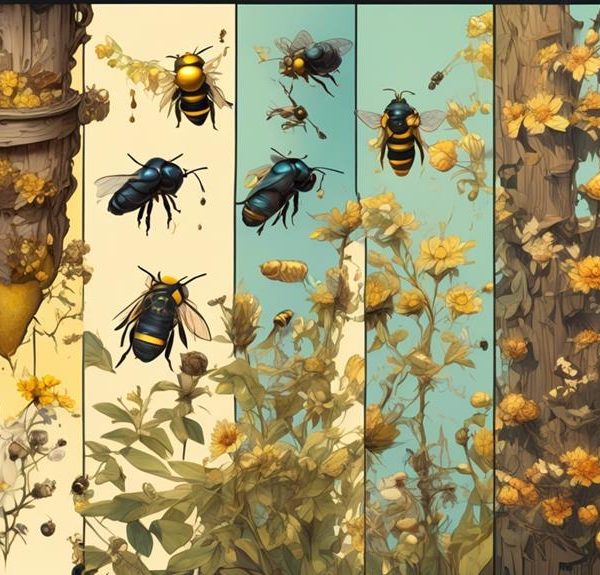Discover the intriguing world of Carpenter Bees, the buzzing builders of New Mexico's ecosystem, and their unique contribution to nature's balance.

Carpenter Bee Species in New Mexico
Beneath the beautiful blue skies of New Mexico, buzzes a breathtaking bee species known as carpenter bees. You might be familiar with their close cousins, the bumblebees, but carpenter bees hold their own unique charm and importance in the ecosystem. They're named for their fascinating ability to bore into wood to set up their homes.
As you stroll through the diverse landscapes in New Mexico, you're likely to encounter these intriguing insects. But what makes them tick? What role do they play in the ecosystem? And how do they contribute to the balance of nature in New Mexico?
Let's embark on this journey to learn more about these buzzing builders.
Key Takeaways
- Carpenter bees in New Mexico are large, shiny, black bees with a smooth and hairless abdomen.
- They are solitary bees that create nests by boring into wood, preferably soft and unpainted.
- Carpenter bees play a crucial role as pollinators for numerous plant species, including the state flower, the Yucca.
- Habitat loss, pesticide use, and climate change are major threats to carpenter bees, and conservation efforts should focus on reducing pesticide use, preserving natural habitats, and advocating for pollinator-friendly policies.
Overview of Carpenter Bees

Diving into the world of Carpenter Bees, you'll find that these fascinating insects, renowned for their wood-boring behavior, represent a unique group within the bee kingdom, exhibiting distinguishing characteristics that set them apart in New Mexico's diverse ecosystem. You'll notice their robust bodies, metallic sheen, and relatively hairless abdomen, contrasting with the typical furry appearance of other bees.
Unlike their hive-dwelling counterparts, Carpenter Bees are solitary creatures. Each bee makes its own individual nest, typically in dead wood or bamboo, where it lays its eggs and provides food for the larvae. The female bee is the primary wood-driller, using her strong mandibles to bore into the wood, creating a near-perfectly round hole.
Carpenter Bees aren't just efficient wood-borers, they're also important pollinators. As they feed on nectar, pollen adheres to their bodies and is subsequently transferred to other flowers. This cross-pollination is crucial for the survival of many plants, contributing to New Mexico's biodiversity.
Despite their intimidating size and loud buzz, Carpenter Bees are generally harmless to humans unless provoked. They're an integral part of New Mexico's environment, demonstrating the complexity and diversity of the state's ecological web.
Identifying New Mexico's Carpenter Bees

To identify New Mexico's Carpenter Bees, it's essential to recognize their distinct physical features and behavioral patterns. These bees are usually large, ranging from half an inch to one inch in length. They're known for their shiny, black bodies, often mistaken for bumblebees. However, unlike bumblebees, carpenter bees have a smooth and hairless abdomen.
In terms of behavior, these bees are solitary, meaning they don't live in colonies. You'll often spot them hovering around wooden structures, as females excavate tunnels in wood to lay their eggs. Males, although they may seem aggressive, can't sting. They'll hover around nest entrances, guarding against intruders.
The most common species you'll encounter in New Mexico is the Valley Carpenter Bee, distinguishable by the females' black bodies and the males' golden color. Another species that you might spot is the Eastern Carpenter Bee, slightly smaller and known for the yellow patch on its abdomen.
Habitat and Distribution of Carpenter Bees

After identifying the various species, you might wonder where these Carpenter Bees make their homes in New Mexico. It's worth noting that these industrious insects can be found in diverse habitats across the state. They're commonly spotted in forests, gardens, and residential areas, making their nests in a variety of wooden structures.
Carpenter Bees prefer to nest in soft, unpainted woods, often choosing dead trees, tree limbs, or human-made structures such as fences, decks, or outdoor furniture. Unlike other bee species, they don't live in colonies but rather in solitary nests. Each female bee excavates a tunnel in the wood, where she lays her eggs.
As for their distribution, Carpenter Bees are found throughout New Mexico, with no particular concentration in any one area. They're more prevalent in places with plenty of flowering plants, as they rely on these for food. They're particularly fond of open, sunny areas and are less common in heavily shaded spots.
Understanding the habitat and distribution of Carpenter Bees is key in managing their impact on human activities. Despite being solitary, their tendency to nest in human structures can sometimes lead to conflicts with people.
Role in New Mexico's Ecosystem

In the grand tapestry of New Mexico's ecosystem, Carpenter Bees play an integral role, acting as crucial pollinators for numerous plant species. These industrious insects are nature's own gardeners. They burrow into wood, creating nests and laying their eggs, but their most significant contribution is pollination.
You see, as Carpenter Bees forage for nectar, they inadvertently transfer pollen from the male part of a flower, the stamen, to the female part, the stigma. This essential process called cross-pollination allows plants to produce fruit and seeds, both of which are vital for plant reproduction and survival.
In New Mexico, Carpenter Bees are especially significant for the pollination of native plants, including the state flower, the Yucca. They're also critical for agriculture, helping to pollinate crops such as tomatoes, peppers, and fruit trees. So, they're not just an important part of the ecosystem, but they're also integral to the state's economy.
Threats and Conservation Efforts

Despite their crucial role in pollination and economic contribution, Carpenter Bees in New Mexico are facing increasing threats that require urgent conservation efforts. Habitat loss, pesticides, and climate change have all been detrimental to their populations.
You must understand that habitat loss, mainly due to urbanization and agricultural intensification, directly impacts their nesting and food sources. Carpenter bees are solitary creatures that nest in dead wood or plant stems. When these are removed, it significantly disrupts their life cycle.
Pesticide use is another major issue. These chemicals, particularly neonicotinoids, are highly toxic to bees. They affect their foraging behavior, reproduction, and survival rates.
Climate change, too, poses a significant risk. Changes in temperature and precipitation patterns can disrupt the natural life cycle of bees, causing a mismatch between bees and the flowering plants they rely on.
Regarding conservation, there's a dire need for sustainable practices. This includes reducing pesticide use, preserving natural habitats, and planting diverse flora that bloom at different times. Public education is also key.
You can support these conservation efforts by planting bee-friendly gardens and advocating for policies that protect these essential pollinators. Remember, their survival means our survival.
Conclusion
So, you've journeyed through the world of New Mexico's carpenter bees. You've identified their distinguishing features, discovered their habitats, and understood their crucial role in the ecosystem.
You've also learned about the threats they face and the efforts to conserve them. With this knowledge, you can appreciate these industrious pollinators more and contribute to their ongoing survival.
Remember, every species plays its part in maintaining our environment, including the humble carpenter bee.



